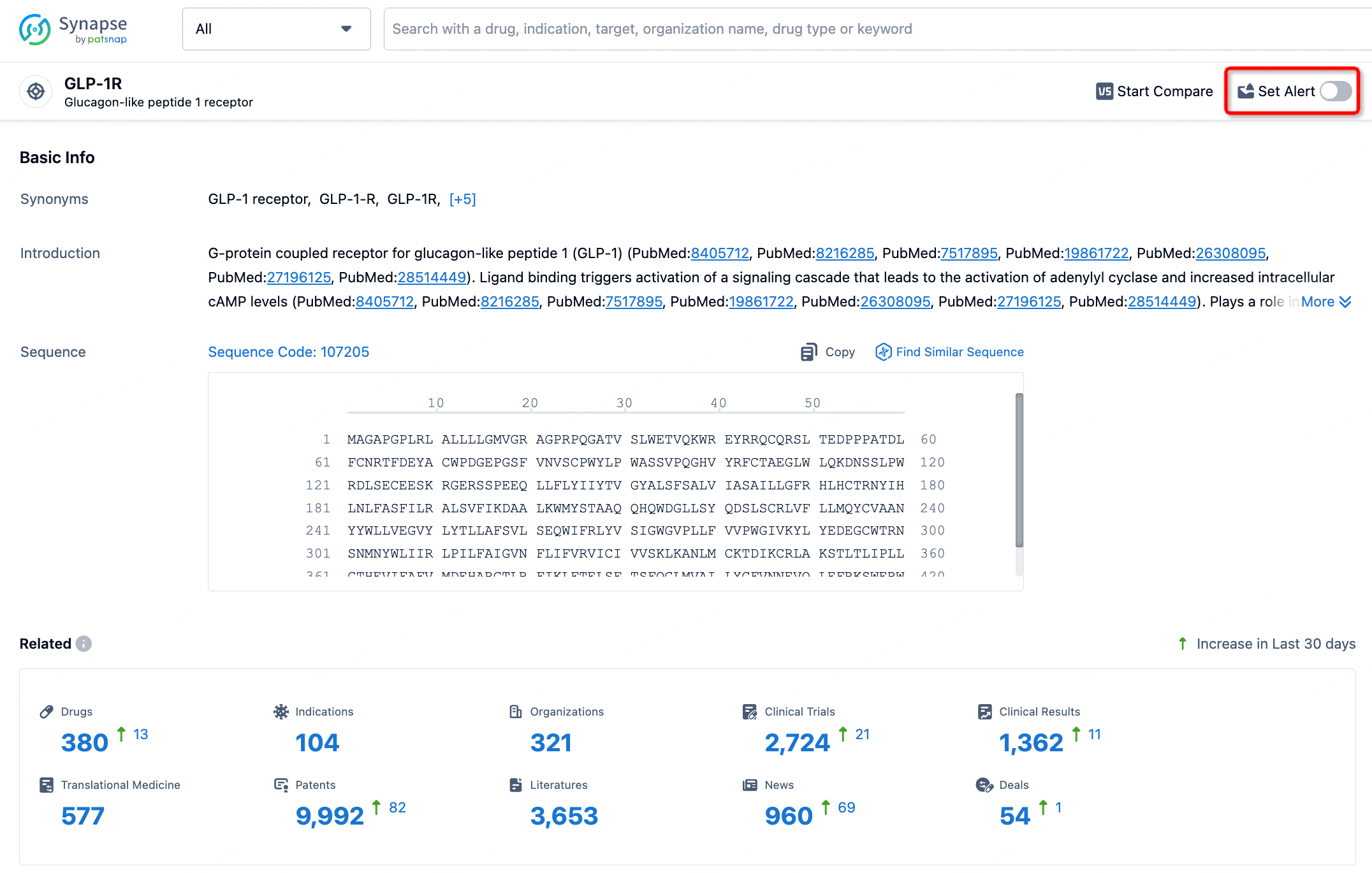Request Demo
What are AAK1 inhibitors and how do they work?
21 June 2024
In recent years, the field of pharmacology has seen significant advancements with the discovery and development of various inhibitors targeting specific enzymes and proteins. Among these, AAK1 inhibitors have garnered substantial interest due to their potential therapeutic applications. But what exactly are AAK1 inhibitors, and how do they work? Let's delve deeper into this emerging area of medical research.
AAK1, or AP2-associated protein kinase 1, is a serine/threonine kinase that plays a pivotal role in the endocytic pathway. This kinase is integral in clathrin-mediated endocytosis, a process that cells use to internalize various molecules from the extracellular environment. By modulating the activity of AAK1, researchers aim to influence the endocytosis and trafficking of specific receptors and proteins, lending to the therapeutic potential of AAK1 inhibitors.
The mechanism of action of AAK1 inhibitors revolves around their ability to block the kinase activity of AAK1. AAK1 phosphorylates the μ2 subunit of the adaptor protein complex 2 (AP2), which is essential for clathrin-coated pit maturation and subsequent vesicle formation. By inhibiting AAK1, these molecules effectively halt the phosphorylation process, thereby disrupting the endocytic cycle. The interruption of this cycle can lead to reduced internalization of target molecules, including cell surface receptors and viral particles, making it a promising strategy for various diseases.
One of the intriguing aspects of AAK1 inhibitors is their potential use in treating viral infections. Viruses often hijack the host cell's endocytic machinery to gain entry and propagate within the cell. By targeting AAK1, it is possible to hinder the viral entry process, thereby limiting infection and spread. For instance, research has shown that AAK1 inhibitors can reduce the infectivity of hepatitis C virus (HCV) by blocking its entry into host cells. This line of investigation opens new avenues for antiviral therapies, especially for viruses that rely heavily on endocytosis for their life cycle.
Beyond viral infections, AAK1 inhibitors are being explored for their role in modulating neurodegenerative diseases. Neurodegenerative conditions, such as Alzheimer’s disease and Parkinson’s disease, involve the aggregation and misfolding of proteins within neurons. Emerging evidence suggests that AAK1 inhibitors might help in regulating the endocytic trafficking of neurotoxic proteins, potentially offering a therapeutic strategy to mitigate disease progression. For instance, the internalization and degradation of amyloid-beta peptides, implicated in Alzheimer's disease, might be influenced by AAK1 activity. By modulating this pathway, AAK1 inhibitors could help reduce the toxic burden of these peptides.
Another promising application of AAK1 inhibitors is in oncology. Cancer cells often exhibit dysregulated endocytic pathways, contributing to unchecked growth and survival. By targeting AAK1, it may be possible to alter the endocytic trafficking of growth factor receptors, leading to reduced proliferation and increased apoptosis of cancer cells. Preliminary studies have indicated that AAK1 inhibitors might enhance the efficacy of existing cancer treatments by sensitizing tumor cells to chemotherapeutic agents.
Furthermore, AAK1 inhibitors may have potential in the field of pain management. Chronic pain conditions are sometimes linked to the aberrant trafficking of pain receptors on sensory neurons. By inhibiting AAK1, it might be feasible to attenuate the signaling pathways involved in chronic pain, offering a novel approach to pain relief.
In conclusion, AAK1 inhibitors represent a versatile and promising class of therapeutic agents with potential applications across a broad spectrum of diseases. By understanding and manipulating the endocytic pathways regulated by AAK1, researchers hope to develop targeted treatments for viral infections, neurodegenerative diseases, cancer, and chronic pain. While many of these applications are still in the experimental stage, the future of AAK1 inhibitors looks promising, holding the potential to usher in new paradigms in disease treatment and management. As research progresses, it will be exciting to see how these inhibitors can be integrated into clinical practice to benefit patients worldwide.
AAK1, or AP2-associated protein kinase 1, is a serine/threonine kinase that plays a pivotal role in the endocytic pathway. This kinase is integral in clathrin-mediated endocytosis, a process that cells use to internalize various molecules from the extracellular environment. By modulating the activity of AAK1, researchers aim to influence the endocytosis and trafficking of specific receptors and proteins, lending to the therapeutic potential of AAK1 inhibitors.
The mechanism of action of AAK1 inhibitors revolves around their ability to block the kinase activity of AAK1. AAK1 phosphorylates the μ2 subunit of the adaptor protein complex 2 (AP2), which is essential for clathrin-coated pit maturation and subsequent vesicle formation. By inhibiting AAK1, these molecules effectively halt the phosphorylation process, thereby disrupting the endocytic cycle. The interruption of this cycle can lead to reduced internalization of target molecules, including cell surface receptors and viral particles, making it a promising strategy for various diseases.
One of the intriguing aspects of AAK1 inhibitors is their potential use in treating viral infections. Viruses often hijack the host cell's endocytic machinery to gain entry and propagate within the cell. By targeting AAK1, it is possible to hinder the viral entry process, thereby limiting infection and spread. For instance, research has shown that AAK1 inhibitors can reduce the infectivity of hepatitis C virus (HCV) by blocking its entry into host cells. This line of investigation opens new avenues for antiviral therapies, especially for viruses that rely heavily on endocytosis for their life cycle.
Beyond viral infections, AAK1 inhibitors are being explored for their role in modulating neurodegenerative diseases. Neurodegenerative conditions, such as Alzheimer’s disease and Parkinson’s disease, involve the aggregation and misfolding of proteins within neurons. Emerging evidence suggests that AAK1 inhibitors might help in regulating the endocytic trafficking of neurotoxic proteins, potentially offering a therapeutic strategy to mitigate disease progression. For instance, the internalization and degradation of amyloid-beta peptides, implicated in Alzheimer's disease, might be influenced by AAK1 activity. By modulating this pathway, AAK1 inhibitors could help reduce the toxic burden of these peptides.
Another promising application of AAK1 inhibitors is in oncology. Cancer cells often exhibit dysregulated endocytic pathways, contributing to unchecked growth and survival. By targeting AAK1, it may be possible to alter the endocytic trafficking of growth factor receptors, leading to reduced proliferation and increased apoptosis of cancer cells. Preliminary studies have indicated that AAK1 inhibitors might enhance the efficacy of existing cancer treatments by sensitizing tumor cells to chemotherapeutic agents.
Furthermore, AAK1 inhibitors may have potential in the field of pain management. Chronic pain conditions are sometimes linked to the aberrant trafficking of pain receptors on sensory neurons. By inhibiting AAK1, it might be feasible to attenuate the signaling pathways involved in chronic pain, offering a novel approach to pain relief.
In conclusion, AAK1 inhibitors represent a versatile and promising class of therapeutic agents with potential applications across a broad spectrum of diseases. By understanding and manipulating the endocytic pathways regulated by AAK1, researchers hope to develop targeted treatments for viral infections, neurodegenerative diseases, cancer, and chronic pain. While many of these applications are still in the experimental stage, the future of AAK1 inhibitors looks promising, holding the potential to usher in new paradigms in disease treatment and management. As research progresses, it will be exciting to see how these inhibitors can be integrated into clinical practice to benefit patients worldwide.
How to obtain the latest development progress of all targets?
In the Synapse database, you can stay updated on the latest research and development advances of all targets. This service is accessible anytime and anywhere, with updates available daily or weekly. Use the "Set Alert" function to stay informed. Click on the image below to embark on a brand new journey of drug discovery!
AI Agents Built for Biopharma Breakthroughs
Accelerate discovery. Empower decisions. Transform outcomes.
Get started for free today!
Accelerate Strategic R&D decision making with Synapse, PatSnap’s AI-powered Connected Innovation Intelligence Platform Built for Life Sciences Professionals.
Start your data trial now!
Synapse data is also accessible to external entities via APIs or data packages. Empower better decisions with the latest in pharmaceutical intelligence.


